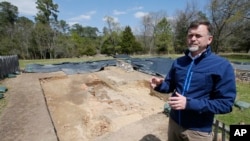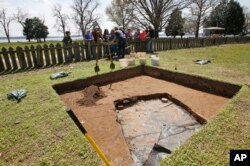On a recent afternoon, tour guide Justin Bates pointed to the spot where historic Jamestown's legislature first convened in July 1619. He then gestured toward another nearby spot where some of the first slaves in English North America arrived a few weeks later.
"Freedom over there,'' Bates told visitors near the banks of Virginia's sprawling James River. "Slavery over here.''
Jamestown has long been associated with the legend of Pocahontas and more recently as a place where a harsh winter turned some colonists into cannibals. But the historic site is now offering a regular tour that encourages visitors to consider the beginnings of American slavery.
The "First Africans'' tour is the first of its kind at the historic site. But it's part of a much larger reckoning over slavery, an institution that took root in England's first permanent colony 12 years after its founding.
In January, President Donald Trump signed into a law the "400 Years of African-American History Commission Act.'' It requires a commission to develop programs that acknowledge the Africans' arrival in 1619 and slavery's impact.
Meanwhile, Virginia has launched its 2019 commemoration, American Evolution. It recognizes the first English-style legislature in North America in Jamestown and other historical milestones from four centuries ago, including the Africans' arrival.
In 1619, the Africans came on two ships, the White Lion and the Treasurer, that had recently raided what's believed to have been a Spanish slave vessel in the Gulf of Mexico. Sailing into the Chesapeake Bay to what is now Hampton, Virginia, the ships traded more than 30 Africans for food and supplies.
From modern-day Angola
English colonists took the Africans, who came from what is now Angola, to properties along the James River, including Jamestown.
A visitors center and monument are planned for the landing site in Hampton. Known then as "Point Comfort,'' the area is now part of Fort Monroe, a former U.S. military base owned by the National Park Service.
"It's a difficult story,'' said Terry E. Brown, the first black superintendent of the Fort Monroe National Monument. "But I want the nation to understand this is an American story.''
Recognition of the enslaved Africans' arrival also provides a counternarrative to the claims of white nationalists that America's roots are white.
"It was not a white society with people of color as interlopers, playing bit parts,'' said James Horn, president of the Jamestown Rediscovery Foundation, which oversees archaeological digs there.
One ongoing excavation focuses on an African woman who was taken to Jamestown in 1619. She had been given the name Angela, likely by the Spanish before her arrival, and lived in the house of Captain William Pierce, a wealthy merchant and planter.
The structure no longer exists. But archaeologists with the National Park Service and Jamestown Rediscovery have uncovered its brick floor and located the kitchen area where Angela likely worked.
The "First Africans'' tour includes the excavation site as well as a spot on the river where Angela likely first stepped off a boat into Jamestown.
"Think about what that must have felt like,'' Bates recently told a group of visitors.
"Scary,'' a woman said.
Kym Hall, the National Park Service's superintendent of Colonial National Historical Park, which includes Jamestown, said tears have been shed at the excavation site. Some of those tears were her own.
"We hope to bring some empathy and connection and understanding about these stories of origin,'' she said.
Just a 'blip'
Some historians are wary of focusing too much on 1619. Davidson College professor Michael Guasco has written that the Africans' arrival in Virginia was just a "blip on the radar screen'' in the larger context of slavery.
More than 500,000 enslaved Africans had already crossed the Atlantic to other European colonies, including places that later became part of the United States.
Guasco warned that too narrow a focus on 1619 risks the implication that the Africans entered an established white society. Jamestown's inhabitants were living "on death's doorstep on the wisp of America.''
"Virginia was still Tsenacommacah, Europeans were the non-native species, and the English were the illegal aliens,'' he wrote in September for Black Perspectives, a blog for the African American Intellectual History Society. Tsenacommacah was the Powhatan people's name for Tidewater Virginia and parts of the Eastern Shore.
Those working at Jamestown have sought to address such concerns, emphasizing its shared racial history.
Bates, the tour guide, charts the history of the European slave trade and the growth of American slavery. He also details the evolution of colonial laws, many passed in Jamestown, that created a race-based system of enslavement.
Jill Williams, a black woman who recently visited the excavation site with her husband and son, said she was unaware of Angela's story until she arrived in Jamestown.
"It's nice to go somewhere and know there's a story about your people. That doesn't always happen,'' said Williams, 52, of Hempstead, New York.
"It's a tough history to grapple with,'' she said of the Africans who arrived in 1619. "But they came here and survived. They took care of people. They raised people.''







